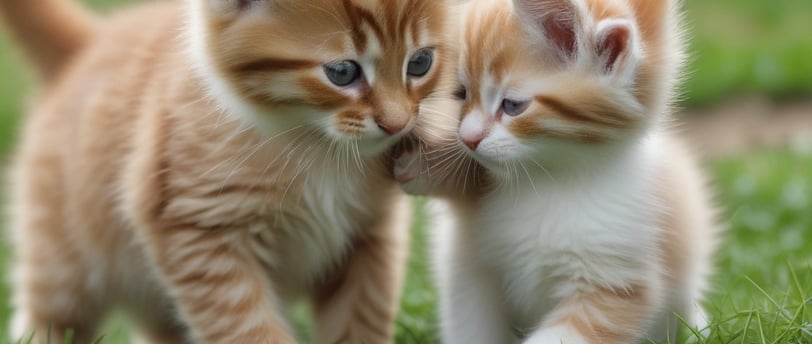How to Add Training to Your New Cat's Weekly Routine
5/11/20255 min read


Understanding Your New Cat's Behavior
When introducing a new cat into your household, it is vital to understand the behaviors that they display. Cats, whether they are kittens or rescues, communicate through a variety of signals which can include vocalizations, body language, and even their grooming habits. For instance, a cat that purrs is generally content, while one that hisses may be feeling threatened or anxious. Recognizing these signs can help you tailor your training approach to your cat's specific needs.
Additionally, cats possess natural instincts that drive their behavior. As predators, they have an innate urge to hunt, explore, and mark their territory. Understanding these instincts can guide you in providing meaningful activities that align with their natural tendencies. For instance, interactive play sessions can satisfy their hunting urges while also strengthening the bond between you and your pet.
Commonly, new cats might exhibit shy or withdrawn behavior as they adjust to their new environment. This can lead to fear-based reactions, which might complicate your training efforts. Patience is crucial in this phase; allowing your feline friend to acclimate to their surroundings at their own pace is essential for successful integration and training.
Cats also enjoy stimulation through play and exploration. Toys that mimic the movements of small prey, such as feather wands or laser pointers, can be particularly engaging and beneficial. It’s crucial to observe what types of activities your cat enjoys most, as this will inform your training regimens and help in keeping your cat motivated and engaged.
Ultimately, understanding your new cat's behavior will facilitate a more effective training approach. By recognizing their communication methods, natural instincts, and preferences, you can create an enriching environment that supports not just training, but the overall well-being of your feline companion.
Setting Up a Training Schedule
Establishing a training schedule for your new cat is crucial for fostering good behavior and enhancing the bond between you and your feline companion. Consistency and routine are key components in ensuring that your training sessions are effective and enjoyable for your cat. A well-structured plan not only aids in the learning process but also helps your cat to understand what you expect from it.
When creating your weekly training schedule, consider the times of day when your cat is most active and alert. Many cats are naturally more energetic in the morning and early evening. Therefore, scheduling training sessions during these periods can lead to more successful outcomes. Aim for short, focused training sessions lasting five to ten minutes—this duration is optimal for maintaining your cat's interest and attention. Frequent, short sessions throughout the week are usually more effective than fewer, longer ones.
Balancing playtime with training is essential to keep your cat engaged and happy. After a training session, consider incorporating a play period with toys that stimulate your cat's hunting instincts. This not only reinforces the skills learned during training but also provides a rewarding experience that keeps your cat motivated. As a guideline, you might alternate one training session with a play session, which can help develop a positive association with the training process.
Additionally, it’s beneficial to have a calendar or reminder system in place. Marking training days on a physical or digital calendar can help you stay consistent and make it easier to track your cat’s progress. Regularly updating your schedule based on your cat’s learning curves and responsiveness will ensure that the training remains relevant and effective. By adhering to these practices, you will create a training routine that contributes positively to your cat’s development and overall happiness.
Effective Training Techniques for Cats
When introducing training to your new cat's weekly routine, implementing effective techniques is crucial for success. Positive reinforcement methods form the cornerstone of cat training, focusing on rewarding desired behaviors rather than punishing unwanted ones. This approach encourages your feline friend to repeat actions that result in positive outcomes. For instance, when your cat uses the litter box correctly, rewarding them with a treat or verbal praise strengthens their association with the behavior.
Clicker training is another highly effective method worth considering. A clicker is a small handheld device that makes a distinct sound when pressed. It marks a specific behavior, allowing your cat to understand precisely what action is being reinforced. For example, when teaching a cat to sit, you can click the clicker the moment your cat lowers its rear to the ground, followed by offering a treat. Over time, your cat will learn to associate the click sound with positive reinforcement.
Using treats during training is not only motivational but also enhances the training experience. Choose small, soft, and palatable treats to keep your cat engaged. Incorporating these treats strategically can facilitate various training goals, such as teaching basic tricks like high fives or rolling over. Moreover, training sessions can play a crucial role in discouraging unwanted behaviors, such as scratching furniture. Redirect your cat's attention to appropriate scratching posts and reward them for using them effectively.
Real-life examples illustrate how consistency and patience are key when training cats. If your cat frequently jumps on the kitchen counter, redirect this behavior by offering a designated perch and rewarding them for using it instead. This not only curbs undesirable actions but also promotes positive habits. Remember to maintain a calm demeanor during training, as a relaxed atmosphere can foster better learning and cooperation from your cat.
Troubleshooting Common Training Challenges
Training a new cat can sometimes present challenges that require thoughtful approaches and patience from the owner. One common issue cat owners encounter is distractions. Cats are naturally curious creatures, often captivated by their surroundings. To mitigate this challenge, it is beneficial to create a training environment that minimizes distractions. This can involve choosing a quiet room in the home, away from television noise or the hustle and bustle of daily activities. Additionally, using high-value treats during training sessions can help to focus your cat’s attention. Rewarding them when they respond correctly reinforces positive behavior, allowing for a more productive training experience.
Another challenge is dealing with a cat's stubbornness. Unlike dogs, cats may not always respond to commands as readily. To combat this, it is crucial to recognize your cat's unique personality and preferences. If a cat appears indifferent to particular commands, try varying the training method or incorporating play into the training session to make it more engaging. Cats often respond better when motivation comes from their natural instincts, such as chasing a toy or engaging in a play session that uses positive reinforcement.
Moreover, fear or anxiety can significantly hinder a cat's ability to learn. Elements such as unfamiliar training routines or loud noises can elevate a cat's stress levels. To address this, pet owners should be aware of their cat's emotional state and proceed at a pace that suits their comfort levels. Creating a sense of safety during training, such as using a soft voice and gentle movements, can help alleviate fear. If necessary, seek the advice of a professional animal behaviorist to tailor a training plan aligned with your cat's specific behavioral needs.
In conclusion, while challenges in cat training are common, understanding and accommodating your cat's unique personality can greatly enhance the training experience. Patience and persistence are key in overcoming obstacles, leading to a well-trained and happy feline companion.
